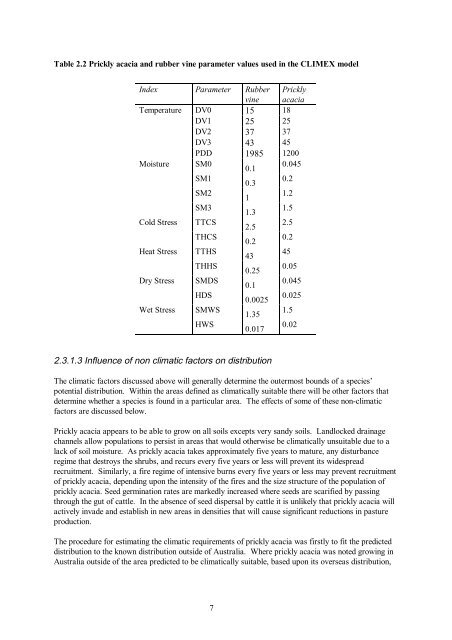EXOTIC WOODY WEEDS Use of simulation models to predict future ...
EXOTIC WOODY WEEDS Use of simulation models to predict future ...
EXOTIC WOODY WEEDS Use of simulation models to predict future ...
You also want an ePaper? Increase the reach of your titles
YUMPU automatically turns print PDFs into web optimized ePapers that Google loves.
Table 2.2 Prickly acacia and rubber vine parameter values used in the CLIMEX model<br />
Index Parameter Rubber<br />
vine<br />
Prickly<br />
acacia<br />
Temperature DV0 15 18<br />
DV1 25 25<br />
DV2 37 37<br />
DV3 43 45<br />
PDD 1985 1200<br />
Moisture SM0<br />
0.1<br />
0.045<br />
SM1<br />
0.3<br />
0.2<br />
SM2<br />
1<br />
1.2<br />
SM3<br />
1.3<br />
1.5<br />
Cold Stress TTCS<br />
2.5<br />
2.5<br />
THCS<br />
0.2<br />
0.2<br />
Heat Stress TTHS<br />
43<br />
45<br />
THHS<br />
0.25<br />
0.05<br />
Dry Stress SMDS<br />
0.1<br />
0.045<br />
HDS<br />
0.0025<br />
0.025<br />
Wet Stress SMWS<br />
1.35<br />
1.5<br />
HWS<br />
0.017<br />
0.02<br />
2.3.1.3 Influence <strong>of</strong> non climatic fac<strong>to</strong>rs on distribution<br />
The climatic fac<strong>to</strong>rs discussed above will generally determine the outermost bounds <strong>of</strong> a species’<br />
potential distribution. Within the areas defined as climatically suitable there will be other fac<strong>to</strong>rs that<br />
determine whether a species is found in a particular area. The effects <strong>of</strong> some <strong>of</strong> these non-climatic<br />
fac<strong>to</strong>rs are discussed below.<br />
Prickly acacia appears <strong>to</strong> be able <strong>to</strong> grow on all soils excepts very sandy soils. Landlocked drainage<br />
channels allow populations <strong>to</strong> persist in areas that would otherwise be climatically unsuitable due <strong>to</strong> a<br />
lack <strong>of</strong> soil moisture. As prickly acacia takes approximately five years <strong>to</strong> mature, any disturbance<br />
regime that destroys the shrubs, and recurs every five years or less will prevent its widespread<br />
recruitment. Similarly, a fire regime <strong>of</strong> intensive burns every five years or less may prevent recruitment<br />
<strong>of</strong> prickly acacia, depending upon the intensity <strong>of</strong> the fires and the size structure <strong>of</strong> the population <strong>of</strong><br />
prickly acacia. Seed germination rates are markedly increased where seeds are scarified by passing<br />
through the gut <strong>of</strong> cattle. In the absence <strong>of</strong> seed dispersal by cattle it is unlikely that prickly acacia will<br />
actively invade and establish in new areas in densities that will cause significant reductions in pasture<br />
production.<br />
The procedure for estimating the climatic requirements <strong>of</strong> prickly acacia was firstly <strong>to</strong> fit the <strong>predict</strong>ed<br />
distribution <strong>to</strong> the known distribution outside <strong>of</strong> Australia. Where prickly acacia was noted growing in<br />
Australia outside <strong>of</strong> the area <strong>predict</strong>ed <strong>to</strong> be climatically suitable, based upon its overseas distribution,<br />
7

















